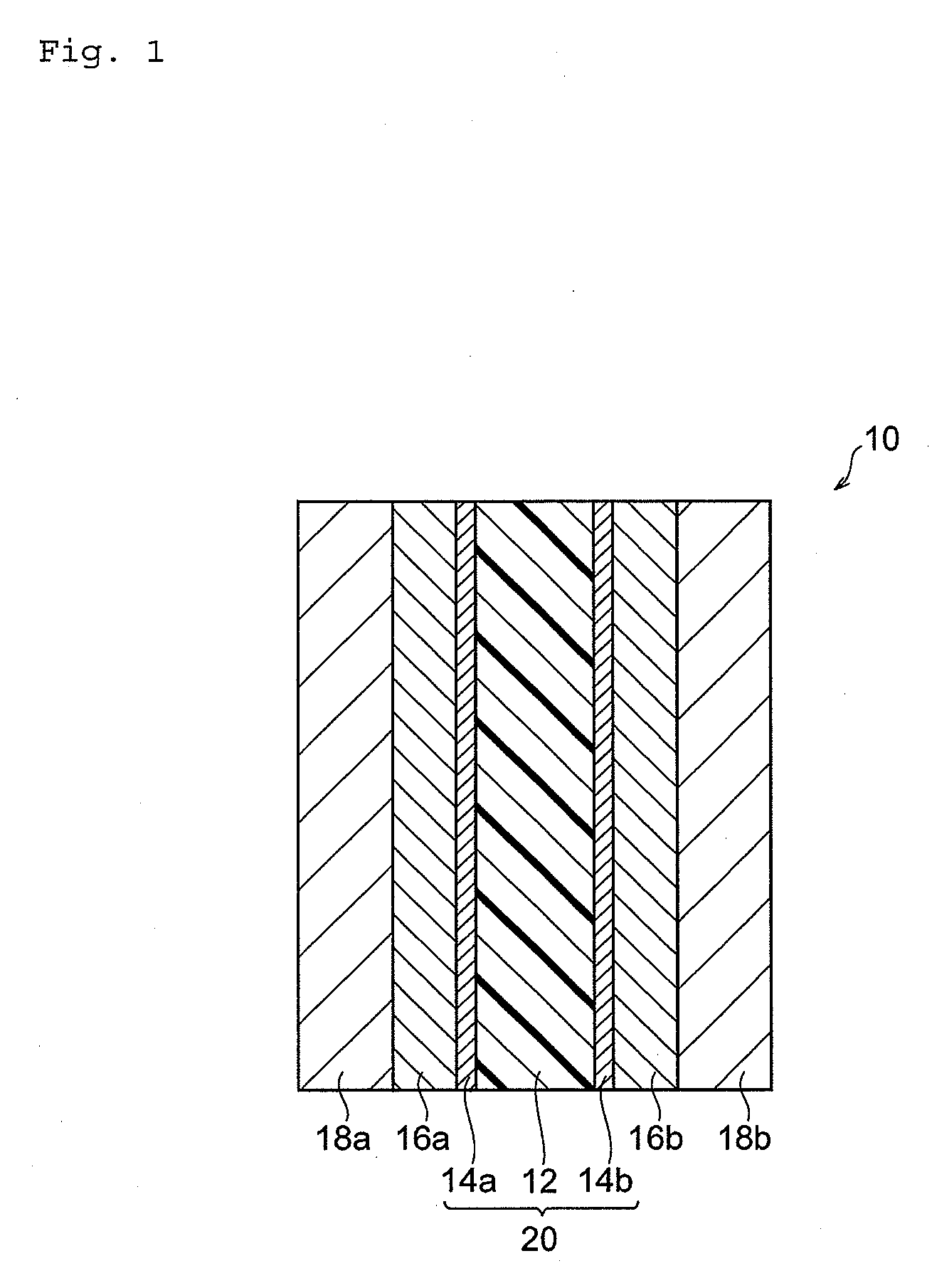Polymer electrolyte, and polymer electrolyte membrane, membrane-electrode assembly and fuel cell that are using the polymer electrolyte
a technology of electrolyte and polymer, applied in the direction of cell components, final product manufacturing, sustainable manufacturing/processing, etc., can solve the problems of not only resistance in the surface direction was lowered, fuel cell output often cannot be sufficient, and the resistance of the surface direction is difficult to achieve high efficiency. , to achieve the effect of small dimensional change, excellent proton conductivity and small membrane resistan
- Summary
- Abstract
- Description
- Claims
- Application Information
AI Technical Summary
Benefits of technology
Problems solved by technology
Method used
Image
Examples
synthesis example 1
[0140]In a flask with an azeotropic distillation apparatus, 65.22 g of 4,4′-difluorodiphenylsulfone, 42.63 g of 2,6-dihydroxynaphthalene (Dainippon Ink And Chemicals, Incorporated), 608 g of N-methyl-pyrrolidone (NMP), and 99 g of toluene were added under an argon atmosphere, and argon gas was bubbled for one hour while stirring at room temperature. After that, 40.45 g of potassium carbonate was added and subjected to azeotropic dehydration by heating at 140° C. while stirring. After that, heating was continued while distilling and removing toluene and polymer J1 was obtained. Total heating time was five hours. The reaction liquid of the obtained polymer J1 was let alone and cooled at room temperature, and then used in the next reaction.
[0141]When weight average molecular weight (Mw) and number average molecular weight (Mn) of Polymer J1 were measured respectively, Mw was 8.3×104 and Mn was 4.6×104. These values are the values obtained by measuring with gel permeation chromatography...
synthesis example 2
[0149]In a flask with an azeotropic distillation apparatus, 83.70 g of 4,4′-difluorodiphenylsulfone, 53.31 g of 2,6-dihydroxynaphthalene, 606 g of NMP, and 102 g of toluene were added under an argon atmosphere, and argon gas was bubbled for one hour while stirring at room temperature. After that, 52.44 g of potassium carbonate was added and subjected to azeotropic dehydration by heating at 140° C. while stirring. After that, heating was continued while distilling and removing toluene and polymer J2 was obtained. The total heating time was 16.5 hours. Mw of polymer J2 was 1.1×105, and Mn was 5.0×104. The reaction liquid of the obtained polymer J2 was let alone and cooled at room temperature, and then used in the next reaction.
[0150]Moreover, in a flask with an azeotropic distillation apparatus, 98.53 g of 4,4′-difluorodiphenylsulfone-3,3′-dipotassium disulfonate, 40.01 g of 2,5-dihydroxybenzene potassium sulfonate, 600 g of dimethyl sulfoxide, and 94 g of toluene were added under an ...
synthesis example 3
[0154]In a flask with an azeotropic distillation apparatus, 249.01 g of 4,4′-difluorodiphenylsulfone, 164.60 g of 2,6-dihydroxynaphthalene, 902 g of NMP, and 294 g of toluene were added under an argon atmosphere, and argon gas was bubbled for one hour while stirring at room temperature. After that, 156.1 g of potassium carbonate was added and subjected to azeotropic dehydration by heating at 140° C. while stirring. After that, heating was continued while distilling and removing toluene and polymer J3 was obtained. The total heating time was 18.5 hours. Mw of polymer J3 was 7.4×104, and Mn was 4.0×104. The reaction liquid of the obtained polymer J3 was let alone and cooled at room temperature, and then used in the next reaction.
[0155]Moreover, in a flask with an azeotropic distillation apparatus, 284.3 g of 4,4′-difluorodiphenylsulfone-3,3′-dipotassium disulfonate, 120.0 g of 2,5-dihydroxybenzene potassium sulfonate, 1778 g of dimethyl sulfoxide, and 279 g of toluene were added under...
PUM
| Property | Measurement | Unit |
|---|---|---|
| ion-exchange capacity | aaaaa | aaaaa |
| ion-exchange capacity | aaaaa | aaaaa |
| temperature | aaaaa | aaaaa |
Abstract
Description
Claims
Application Information
 Login to View More
Login to View More - R&D
- Intellectual Property
- Life Sciences
- Materials
- Tech Scout
- Unparalleled Data Quality
- Higher Quality Content
- 60% Fewer Hallucinations
Browse by: Latest US Patents, China's latest patents, Technical Efficacy Thesaurus, Application Domain, Technology Topic, Popular Technical Reports.
© 2025 PatSnap. All rights reserved.Legal|Privacy policy|Modern Slavery Act Transparency Statement|Sitemap|About US| Contact US: help@patsnap.com



